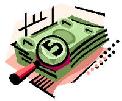
 |
|
| Financial Terms | |
| regression line |
|
Information about financial, finance, business, accounting, payroll, inventory, investment, money, inventory control, stock trading, financial advisor, tax advisor, credit.
Main Page: inventory, financial, accounting, stock trading, finance, credit, tax advisor, inventory control, |
Definition of regression line
regression lineany line that goes through the means (or averages) of the set of observations for an independent variable and its dependent variables; mathematically, there is a line of “best fit,” which is the least squares regression line
Related Terms:Linear regressionA statistical technique for fitting a straight line to a set of data points. Simple linear regressionA regression analysis between only two variables, one dependent and the other explanatory. coefficient of determinationa measure of dispersion that dispersionthe degree of variability or difference; it is measured least squares regression analysisa statistical technique that investigates the association between dependent and independent variables; it determines the line of "best fit" for a set of observations by minimizing the sum of the squares standard error of the estimatea measure of dispersion that reflects the average difference between actual observations and expected results provided by a regression line Bank lineline of credit granted by a bank to a customer.  Capital market line (CML)The line defined by every combination of the risk-free asset and the market portfolio. Cash flow time-lineline depicting the operating activities and cash flows for a firm over a particular period. Characteristic lineThe market model applied to a single security. The slope of the line is a security's beta. Demand line of creditA bank line of credit that enables a customer to borrow on a daily or on-demand basis. Euro lineslines of credit granted by banks (foreign or foreign branches of U.S. banks) for Eurocurrencies. First-pass regressionA time series regression to estimate the betas of securities portfolios. Investment product line (IPML)The line of required returns for investment projects as a function of beta Line of credit An informal arrangement between a bank and a customer establishing a maximum loan Linear programmingTechnique for finding the maximum value of some equation subject to stated linear constraints.  Log-linear least-squares methodA statistical technique for fitting a curve to a set of data points. One of the Line of creditAn informal arrangement between a bank and a customer establishing a maximum loan Mortgage pipelineThe period from the taking of applications from prospective mortgage borrowers to the Mortgage-pipeline riskThe risk associated with taking applications from prospective mortgage borrowers Multiple regressionThe estimated relationship between a dependent variable and more than one explanatory variable. Old-line factoringFactoring arrangement that provides collection, insurance, and finance for accounts receivable. Regression analysisA statistical technique that can be used to estimate relationships between variables. Regression equationAn equation that describes the average relationship between a dependent variable and a Regression toward the meanThe tendency for subsequent observations of a random variable to be closer to its mean. Revolving line of creditA bank line of credit on which the customer pays a commitment fee and can take Second pass regressionA cross-sectional regression of portfolio returns on betas. The estimated slope is the Security characteristic lineA plot of the excess return on a security over the risk-free rate as a function of Security market lineline representing the relationship between expected return and market risk. Simple linear trend modelAn extrapolative statistical model that asserts that earnings have a base level and Straight line depreciationAn equal dollar amount of depreciation in each accounting period. Swingline facilityBank borrowing facility to provide finance while the firm replaces U.S. commercial paper STRAIGHT-LINE DEPRECIATIONA depreciation method that depreciates an asset the same amount for each year of its estimated Line itemGeneric types of assets, liabilities, income or expense that are common to all businesses and Straight-lineA method of depreciation. bottom lineA commonly used term that refers to the net income (profit) net income (also called the bottom line, earnings, net earnings, and netoperating earnings) straight-line depreciationThis depreciation method allocates a uniform Security Market LineA graph illustrating the equilibrium relationship between the line employeean employee who is directly responsible for linear programminga method of mathematical programming used to solve a problem that involves an objective function and multiple limiting factors or constraints long-term variable cost a cost that was traditionally viewed as a fixed cost Management Accounting Guidelines (MAGs)pronouncements of the Society of Management Accountants of multiple regressiona statistical technique that uses two or product line marginsee segment margin red-line systeman inventory ordering system in which a red simple regressiona statistical technique that uses only one independent variable to predict a dependent variable timelinerepresentation of the amounts and timing of all Regression analysisStatistical analysis techniques that quantify the line of creditAgreement by a bank that a company may borrow at any time up to an established limit. security market lineRelationship between expected return and beta. straight-line depreciationConstant depreciation for each year of the asset’s accounting life. 45-Degree LineA line representing equilibrium in the goods and services market, on a diagram with aggregate demand on the vertical axis and aggregate supply on the horizontal axis. Other-than-Temporary Decline in Market ValueThe standard used to describe a decline in market value that is not expected to recover. The use of the other-than-temporary description as Formalized Line of CreditA contractual commitment to make loans to a particular borrower up to a specified maximum during a specified period, usually one year. Line of CreditAn agreement negotiated between a borrower and a lender which establishes the maximum amount against which a borrower may draw. The agreement also sets out other conditions, such as how and when money borrowed against the line of credit is to be repaid. Operating Line of CreditA bank's commitment to make loans to a particular borrower up to a specified maximum for a specified period, usually one year. line of creditA revolving source of credit with a pre-established limit. You access the funds only as you need them, and any amount that you pay back becomes accessible to you again. Unlike a personal loan, a line of credit permits you to write cheques and make bank machine withdrawals, and requires you to pay interest only on the funds that you actually use. online bill paymentThe electronic payment of a bill via the Internet. The specified amount of the bill is electronically debited from your account. personal line of credit (PLC)A revolving source of credit with a pre-established limit. You access the funds only as you need them, and any amount that you pay back becomes accessible to you again. Unlike a personal loan, a PLC permits you to write cheques and make bank machine withdrawals, and requires you to pay interest only on the funds that you actually use. secured loan or line of creditA lump sum of funds (loan), or a revolving source of credit with a pre-established limit (line of credit), for which the customer must provide collateral. Personal Line of credit (Credit Insurance)A bank's commitment to make loans to a borrower up to a specified maximum during a specific period, usually one year. R squared (R^2)Square of the correlation coefficient proportion of the variability explained by the linear Related to : financial, finance, business, accounting, payroll, inventory, investment, money, inventory control, stock trading, financial advisor, tax advisor, credit. |